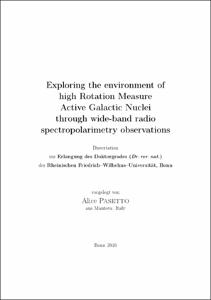Pasetto, Alice: Exploring the environment of high Rotation Measure Active Galactic Nuclei through wide-band radio spectropolarimetry observations. - Bonn, 2016. - Dissertation, Rheinische Friedrich-Wilhelms-Universität Bonn.
Online-Ausgabe in bonndoc: https://nbn-resolving.org/urn:nbn:de:hbz:5n-45252
Online-Ausgabe in bonndoc: https://nbn-resolving.org/urn:nbn:de:hbz:5n-45252
@phdthesis{handle:20.500.11811/6913,
urn: https://nbn-resolving.org/urn:nbn:de:hbz:5n-45252,
author = {{Alice Pasetto}},
title = {Exploring the environment of high Rotation Measure Active Galactic Nuclei through wide-band radio spectropolarimetry observations},
school = {Rheinische Friedrich-Wilhelms-Universität Bonn},
year = 2016,
month = dec,
note = {In this Thesis I present an observational study of a sample of radio AGN sources. I study their radio polarization properties in a wide frequency range by observing with the 100-m Effelsberg telescope and the Very Large Array (VLA) interferometer. The aim was 1) to define a sample of candidates to contain an extreme environment around the SMBH and, 2) to study their environment by modeling of the polarization properties within a wide frequency range.
I select sources with no detectable flux polarization at 1.4GHz in the NVSS survey, characteristic of strong depolarization due to a high value of Rotation Measure (RM) and thus, of an extreme medium in these sources.
I performed single dish observations at 10.45 GHz using the 100-m Effelsberg telescope. At this high frequency, I detected polarized flux density on 30 sources, which became our high-RM candidates. Single dish follow-up in the 2 to 15 GHz frequency range, were performed to characterize their radio spectra and to determine their RMs. The polarization angle behavior deviates significantly from the lambda^2 law, suggesting that several Faraday screens are present in the intervening medium. I studied the most interesting high-RM cases through wide-band high sensitive observations at C and X bands using the JVLA. I modeled the polarization properties constructing a set of models which are combinations of simple internal and the external Faraday screens. This new approach of polarization study allows to spectrally resolve multiple polarized components of unresolved AGN with the result to trace some clumpy and dense region surrounding them. This new spectropolarimetry approach can be adopted as a new way to trace clumpy and dense regions surrounding the AGN.},
url = {https://hdl.handle.net/20.500.11811/6913}
}
urn: https://nbn-resolving.org/urn:nbn:de:hbz:5n-45252,
author = {{Alice Pasetto}},
title = {Exploring the environment of high Rotation Measure Active Galactic Nuclei through wide-band radio spectropolarimetry observations},
school = {Rheinische Friedrich-Wilhelms-Universität Bonn},
year = 2016,
month = dec,
note = {In this Thesis I present an observational study of a sample of radio AGN sources. I study their radio polarization properties in a wide frequency range by observing with the 100-m Effelsberg telescope and the Very Large Array (VLA) interferometer. The aim was 1) to define a sample of candidates to contain an extreme environment around the SMBH and, 2) to study their environment by modeling of the polarization properties within a wide frequency range.
I select sources with no detectable flux polarization at 1.4GHz in the NVSS survey, characteristic of strong depolarization due to a high value of Rotation Measure (RM) and thus, of an extreme medium in these sources.
I performed single dish observations at 10.45 GHz using the 100-m Effelsberg telescope. At this high frequency, I detected polarized flux density on 30 sources, which became our high-RM candidates. Single dish follow-up in the 2 to 15 GHz frequency range, were performed to characterize their radio spectra and to determine their RMs. The polarization angle behavior deviates significantly from the lambda^2 law, suggesting that several Faraday screens are present in the intervening medium. I studied the most interesting high-RM cases through wide-band high sensitive observations at C and X bands using the JVLA. I modeled the polarization properties constructing a set of models which are combinations of simple internal and the external Faraday screens. This new approach of polarization study allows to spectrally resolve multiple polarized components of unresolved AGN with the result to trace some clumpy and dense region surrounding them. This new spectropolarimetry approach can be adopted as a new way to trace clumpy and dense regions surrounding the AGN.},
url = {https://hdl.handle.net/20.500.11811/6913}
}






